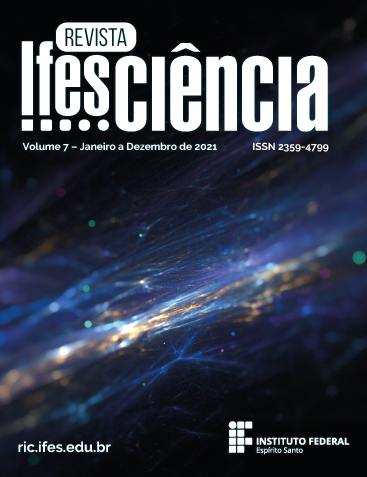ADJUSTMENT OF MATHEMATICAL MODELS TO DETERMINE QUALITY CHARACTERISTICS OF PINEAPPLE FRUITS VITÓRIA CULTIVAR
DOI:
https://doi.org/10.36524/ric.v7i1.1216Palabras clave:
Ananas comosus L., non-destructive method, statistical modelingResumen
The objective of this study was to adjust and validate mathematical models to estimate physical and chemical characteristics of pineapple fruits (Ananas comosus L.) through their linear dimensions. For this purpose, 130 fruits of the cultivar BRS Vitória were used, produced at the experimental farm of the Capixaba Institute of Research, Technical Assistance and Rural Extension, located in the municipality of Sooretama, North of the State of Espírito Santo, Brazil. Of all fruits, the length (L), diameter (D), mass (M), titratable acidity (TA) and soluble solids (SS) were determined. For the modeling, the characteristics M, TA and SS were used as a dependent variable in function of L and D of the fruits, being adjusted the models of equation of first degree linear, quadratic and power. All equations were valid, thus obtaining the mean absolute error, root mean square error and Willmott d index. The diameter showed a better relationship with the physical and chemical characteristics of the pineapple fruit cultivar BRS Vitória, the equations being y = 0.0015(D)^2.7451, y = 1.076350-0.261046(D)+0.018081(D)^2 e y = 21.91682-4.58785(D)+0.31048(D)^2 more suitable for estimating the mass, titratable acidity and soluble solids respectively, in a simple, safe and without the need to destroy the fruits.
Descargas
Publicado
Número
Sección
Licencia
Derechos de autor 2021 Revista Ifes Ciência

Esta obra está bajo una licencia internacional Creative Commons Atribución-NoComercial-SinDerivadas 4.0.
Autores que publicam nesta revista concordam com os seguintes termos:
- Autores mantém os direitos autorais e concedem à revista o direito de primeira publicação, com o trabalho simultaneamente licenciado sob a Licença Creative Commons Attribution que permite o compartilhamento do trabalho com reconhecimento da autoria e publicação inicial nesta revista.
b. Autores têm permissão e são estimulados a publicar e distribuir seu trabalho online (ex.: em repositórios institucionais ou na sua página pessoal) a qualquer ponto antes ou durante o processo editorial, já que isso pode gerar alterações produtivas, bem como aumentar o impacto e a citação do trabalho publicado (Veja O Efeito do Acesso Livre).



